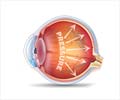A study on monkeys has shed new light on Blindsight-a phenomenon in which patients with damage in the primary visual cortex of the brain can tell where an object is, even when they
Blindsight: This is an interesting phenomenon in which despite damage to the primary visual cortex, the brain can tell where an object is though rendered unable to see it. A recent study on monkeys has brought into focus more information on this strange fact.
Professor Tadashi Isa and Dr. Masatoshi Yoshida, who led the study at the National Institute for Physiological Sciences in Japan, said that they had uncovered compelling evidence that blindsight occurs because visual information is conveyed bypassing the primary visual cortex.Published in the Journal of Neuroscience, their findings have been backed by Japan Science and Technology Agency supported.
For their research, the researchers recorded eye movements of the monkeys that had damage in one side of the primary visual cortex.
The animals were trained with an eye movement task for two to three months, enabling them to move their eyes to the correct direction where an object was even in the affected side of their visual fields.
The researchers said that the animals' brains became able to feel where an object was without 'seeing' it.
According to them, the eye movements among the trained monkeys looked almost normal, for they could discriminated five different directions even in the affected visual field.
The researchers observed two differences from the normal: the trajectory of their eye movements was straight, and the response time of their eye movement was short.
The team concluded that the monkeys' eye movements after damage in the primary visual cortex were mediated by a qualitatively different vision, which is supported by alternative brain circuits bypassing the primary visual cortex.
"Our finding will provide a new strategy for rehabilitation of these patients with damage in the primary visual cortex. That will be a rehabilitation training to activate alternative brain circuits to see what you do not see", said Dr. Yoshida.
"A similar training may help the patients to know where an object is even without 'seeing' it," the researcher added.
Source-ANI
TAN/M
 MEDINDIA
MEDINDIA




 Email
Email








